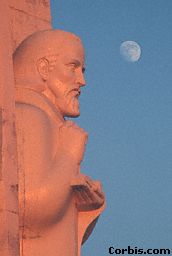

The die is cast; I have written my book; it will be read either in the present age or by posterity, it matters not which; it may well await a reader, since God has waited six thousand years for an interpreter of his words." - Johannes Kepler
Johannes Kepler was a German mathematician and astronomer. He combined his love of numbers with a fascination of the universe to make many important theories and discoveries. Kepler has contributed to many different fields, including calculus, algebra, astronomy, optics, navigation, and even music.

KEPLER: THE EARLY YEARS
Kepler was born December 27, 1571, near Stuggart in Wurtenburg. His father owned a tavern, and so Kepler worked as a pot-boy between the ages of nine and twelve. Unfortunately, he was a sickly child who was often violently ill. Kepler was sent to a monastic school, he attended seminaries at Adelberg and Maulbronn, and then went to the University of Tubingen. While there, he studied theology, philosophy, and mathematics. Kepler graduated from that school second on the list. At age 22, he was appointed professor, and moved to Gratz in Austria to teach mathematics and astronomy.
TYCHO BRAHE AND KEPLER
When Kepler corresponded with Tycho Brahe, his interest in astronomy grew. Then, in 1599, Kepler went to Prague to become Tycho's assistant. Tycho asked Kepler to finish his tables of planetary motion, so when he died in 1601, Kepler became his successor. The tables were eventually finished, and Kepler managed somehow to get the money to publish them. These tables were the first accurate ones for navigators to use.
THE THREE GREAT LAWS OF PLANETARY MOTION
1. The orbit of each planet is an ellipse, with the sun at a focus.
2. The line joining the planet to the sun sweeps out equal areas in equal times.
3. The square of the period of the planet is proportional to the cube of its mean distance to the sun. [1]
Ever since ancient times, the orbits of the planets were thought to be circular, the "perfect" shape. However, Kepler could not explain Tycho's observations with Mars having a circular orbit. Finally, Kepler thought of trying an ellipse, and everything fell into place. Thus the first law came into being. The first two laws were published in "Astronomia Nova" in 1609. The third was published in "Harmonices Mundi" in 1619. That particular book was on the list of books prohibited by the church.
GEOMETRY
Someone once said of Johannes Kepler that "here was a genius spoilt for mathematics by his interest in astronomy."[2] However, Kepler did make many contributions to mathematics, including Geometry. Besides coming up with the Three Laws, Kepler theorized that the five regular solids represented the orbits of the known planets. He did a lot of work with this. He also elaborated the properties of the thirteen semi-regular solids of Archimedes. When Kepler observed light coming from distant stars, he made the suggestion that parallel lines have a common point at infinity. He also touched upon the theory of recurring series and difference relations.
CALCULUS AND OTHER AREAS OF MATH
Kepler became interested in calculus partly through reading Archimede's writings, and partly so that he could improve the methods used to measure wine casks. Thus, he developed accurate methods of calculating the size of areas within curved lines. Kepler also contributed to other areas in math. A document of his contained a number system based on Roman numerals. He used the numbers 1,3,9, and 27 as I, V, X, and L. In this system, the number 20 would equal 27-9+3-1.
KEPLER AND MUSIC
In addition to the sciences, Kepler was interested in music. He believed that there was harmony in the universe. In his book "Harmonices Mundi", Kepler discussed the relationship between musical intervals and the distances of the planets to the sun. He believed that every planet "sang it's tune." He related the notes m, f, m to Earth. This is a planet of suffering. Venus reminded Kepler of a monotone, while Mercury, with a more elliptical orbit than the other planets, had an appreggio-like orbit.
OTHER DISCOVERIES
Johannes Kepler studied optics. He accurately explained the human eye, and made hypotheses on the refraction of light in dense materials. In astronomy, another important discovery he made was that the plane of a planet's orbit did not tip up or down - it was fixed in space.
THE DEATH OF A SCIENTIST
 Kepler had a rough life of financial troubles. He involved himself in
astrology for money, but he hated it. When Kepler was 59 years old, he went to Prague to
try and get the salary he was owed. He caught a fever and died there, on November 15,
1630, and he was buried at Ratisbon. A few years ago, it was suggested that a monument be
built for him, but it never happened.
Kepler had a rough life of financial troubles. He involved himself in
astrology for money, but he hated it. When Kepler was 59 years old, he went to Prague to
try and get the salary he was owed. He caught a fever and died there, on November 15,
1630, and he was buried at Ratisbon. A few years ago, it was suggested that a monument be
built for him, but it never happened.
Kepler has been described as:
. . . a man of affectionate disposition, abundant energy and methodical habits, with the intuition of true genius and the readiness to look for new relationships between familiar things. He combined a love of general principles with the habit of attending to details. [3]
Johannes Kepler has contributed greatly to the fields of science and mathematics. He paved the way for future scientists, by changing the way we view the universe and the world around us.
FOOTNOTES:
[1] Newman, James R., The World of Mathematics (New York, 1956), p. 126.
[2] Ibid., p. 127.
[3] Ibid., p.124.
BIBLIOGRAPHY
"Astronomy," Funk and Wagnalls New Encyclopedia of Science (1986 ed.), vol. 2, 107-110.
Bergamini, David. Life Nature Library. New York: Time-Life Books, 1971.
"Kepler, Johannes," The New Groiler Multimedia Encyclopedia (1993 ed.)
Newman, James R. The World of Mathematics. Volume 1. New York: Simon and Schuster, 1956.
Webster's Dictionary Including Thesaurus. New York: Pamco Publishing Company, Inc., 1992.
Fall 1994
Related books for sale on Amazon.com:
The World of Mathematics by James R. Newman
Funk and Wagnalls New Encyclopedia of Science
Life Nature Library
Grolier Multimedia Encyclopedia (CD-ROM)
Merriam-Webster's Collegiate Dictionary
| Home | Chemistry | Physics | Astronomy | Biology | Ecology |
| Geography | Medicine | Mathematics | Technology |
| Issues | Scientists | General | Reference |
Last Updated Sunday, August 26, 2007 22:42 -0400
� Suzanne P. Currie 1999 [email protected]